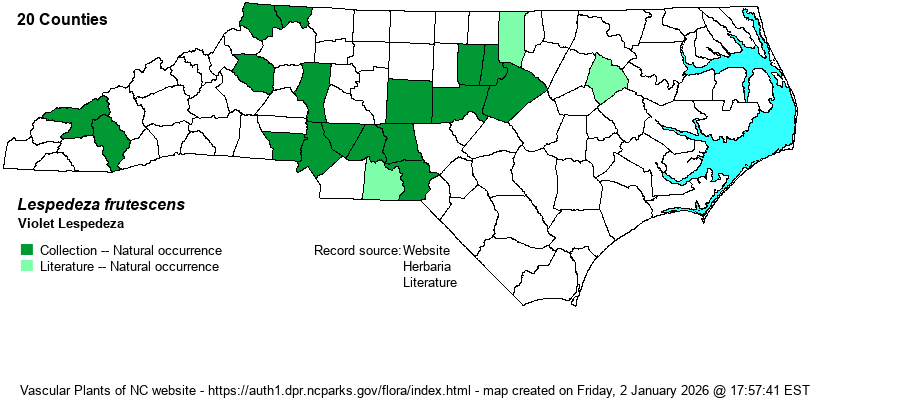| Section 6 » Order Fabales » Family Fabaceae |
Show/Hide Synonym
| taxonName | relationship | relatedTaxonName | relatedTaxonRefText | relComments |
|---|
|
|
|
|
|
| Lespedeza frutescens | = | Lespedeza violacea | Gleason and Cronquist (1991) | , misapplied | | Lespedeza frutescens | = | Lespedeza violacea | Fernald (1950) | , misapplied | | Lespedeza frutescens | = | Lespedeza violacea | Gleason (1952) | , misapplied | | Lespedeza frutescens | = | Lespedeza violacea | Isely (1998)=I. Key based primarily on Z and SE. [also see Kummerowia] | , misapplied | | Lespedeza frutescens | = | Lespedeza violacea | | , misapplied | | Lespedeza frutescens | = | Lespedeza violacea | | , misapplied | | Lespedeza frutescens | = | Lespedeza violacea | Radford, Ahles, and Bell (1968) | , misapplied | | Lespedeza frutescens | = | Lespedeza violacea | Vascular Flora of the Southeastern States (Cronquist 1980, Isely 1990) | , misapplied | | Lespedeza frutescens | = | Lespedeza violacea | | , misapplied | | Lespedeza frutescens | = | Lespedeza violacea | Wofford (1989) | , misapplied | | Lespedeza frutescens | = | Lespedeza violacea | Flora of West Virginia | , misapplied | | Lespedeza frutescens | = | Lespedeza violacea | Isely (1998)=I. Key based primarily on Z and SE. [also see Kummerowia] | , misapplied | | Lespedeza frutescens | = | Lespedeza violacea | Isely (1998)=I. Key based primarily on Z and SE. [also see Kummerowia] | , misapplied | | Lespedeza frutescens | < | Lespedeza violacea | Wunderlin & Hansen Flora of Florida (3) | | | Source: Weakley's Flora |
|
| Author | (L.) Hornemann | |
| Distribution | Widely scattered over most of the Piedmont and Mountains, and one record for the Coastal Plain (Edgecombe County).
This is a widespread species in the Eastern states, though the bulk of the range lies to the north and west of the state. It ranges from ME and southeastern NE, south to central GA and central TX.
| |
| Abundance | Rare in the Piedmont and Mountains, and very rare in the Coastal Plain; perhaps locally uncommon in parts of the eastern and southern Piedmont, though this might be due to observer coverage. This is the rarest native Lespedeza in NC, one in which most biologists are not familiar. Not surprisingly, the NCNHP lists it as a Watch List species. This species was formerly treated as L. violacea (as in RAB 1968) but that epithet now is given to the common statewide species formerly named as L. intermedia. Since some herbaria have not kept up-to-date, the website editors cannot feel comfortable using SERNEC specimen data face value, though the range map below seems fairly accurate. | |
| Habitat | Unlike most others in the genus, this is a species of woodlands and small openings in woodlands/forests, preferring partial shade, in mesic and dry soils. In VA, it favors high pH and often dry or rocky soils, but there does not seem to be enough information on the habitats in NC to state that it is limited to, or found mainly on, circumneutral soils. However, owing to its scarcity in the state, an association with rare soil types might well be the case, as if it favored acidic soils, which are abundant across the state, one would expect many more records. | |
| Phenology | Blooms from July to September, and fruits from October into November. | |
| Identification | This is a bushy Lespedeza, clearly herbaceous and not woody, with a moderate number of ascending to spreading branches. It grows to about 2 feet tall and often nearly as wide and is generally glabrous or only sparsely hairy. The leaves consist of 3 leaflets, and each leaflet is widely elliptic with a rounded apex, about 3/4-inch long and 1/2-inch wide; the petioles can be moderately long, some being close to 1 inch long. However, it can identified by the very long flowering stalks, which are mostly axillary; the stalk is often 2-3 inches long, with only a few widely scattered flowers along the axis, such that the entire inflorescence far exceeds the leaflets. Each flower is purple and about 1/3-inch long. Thus, in summary, look for a bushy-looking lespedeza (with 3 typically elliptical leaflets) that has very long flowering stalks (extending beyond the leaves) containing only a few purple flowers. As this is such a poorly known species in the state -- though clearly scarce, more observations on habitat types would be greatly appreciated, as there is little information available to help biologists in search of this shrubby-looking lespedeza. | |
| Taxonomic Comments | As mentioned above, for much or most of the 20th Century, this species was named as L. violacea. Confusingly, the former L. intermedia was re-named as L. violacea, and the rarer species (in NC) was re-named as L. frutescens.
| |
| Other Common Name(s) | Violet Bush-clover, Shrubby Bush-clover | |
| State Rank | S2? [S2] | |
| Global Rank | G5 | |
| State Status | W7 [W1] | |
| US Status | | |
| USACE-agcp | | |
| USACE-emp | | |

